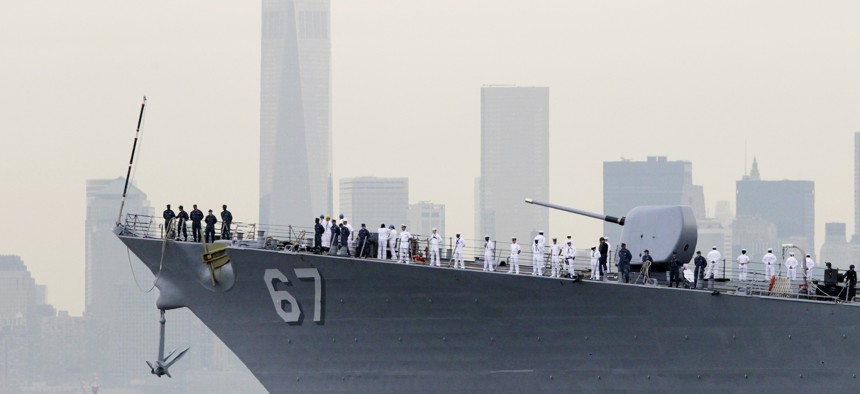
Sailors line the bow of the destroyer USS Cole as it glides past One World Trade Center and the lower Manhattan skyline, Wednesday, May 21, 2014 in New York. ap photo/mark lennihan
America Still Doesn’t Know What to Do With Terrorism Suspects
Some pre-9/11 plotters have not yet been brought to justice, even as a new generation of suspects is taking their place.
Almost 20 years have passed since suicide bombers blew a hole into the USS Cole, killing 17 sailors in a brazen prelude to the September 11th attacks that came a year later. Yet the U.S. still hasn’t fully settled the question of how to bring terrorism suspects to justice—and the diverging fates of two of the Coleplotters show how the confused approach haunts U.S. national security.
In the first case, Jamal al-Badawi, who helped coordinate logistics for the attack, was caught, tried, and incarcerated in Yemen, where he escaped prison twice and was finally set free before being killed in an American air strike this month. In the second, Abd al-Rahim al-Nashiri, the actual alleged mastermind of the attack, remains in legal purgatory in Guantánamo Bay—yet another pretrial hearing took place this week—in part because his confessions were obtained under torture.
Their stories demonstrate not just the failures of some U.S. counterterrorism experiments, but just how difficult those failures are to correct. The families of civilians accidentally killed in air strikes have borne some of the highest costs. Early missteps have also hurt the United States: Some of Badawi’s co-conspirators in the Cole attack went on to plot 9/11; even later, some of his prison cohorts founded al-Qaeda in the Arabian Peninsula, now the most virulent branch of the group.
“These problems pre-existed 9/11, this question of what are the proper array of options for incapacitating a dangerous person,” says Robert Chesney, a law professor at University of Texas at Austin who worked on detention policy in the Obama administration.
The U.S. military’s detention facility at Guantánamo Bay remains open and its justice system ineffectual; air strikes on terrorism suspects have disrupted dangerous plots but have also engendered bitterness and helped foment radicalization. In Syria, where U.S.-backed Kurdish forces are holding hundreds of isis suspects from dozens of countries—including in the Middle East, Europe, and the United States—a new test is coming. The Kurds can’t hold them indefinitely, and absent some plan for what to do with them, they could be sent home to regimes that will torture them—or might simply walk free to help isis rebuild just as the U.S. is leaving.
“The most reliable system, by far, by any measure is criminal prosecution,” Chesney told me. Over the period Nashiri has been in Guantánamo, for instance, American courts have produced more than 600 terrorism-related convictions; Guantánamo has had only a handful, and Nashiri himself hasn’t even been brought to trial. So once a terrorism suspect is captured, criminal prosecution is far more efficient than a military commission at Guantánamo, but Chesney noted it’s not always feasible to apprehend a terrorism suspect regardless, for instance when doing so might be too dangerous.
In the Cole case, the spectrum ranged from military detention, to proxy imprisonment, to lethal force. The crime at the center was grave. The Navy destroyer was part of a mission to enforce sanctions against Saddam Hussein’s regime in Iraq and had stopped to refuel at the Yemeni port city of Aden on October 12, 2000. A skiff bearing two suicide bombers approached it and blew up, ripping a hole in the ship and killing 17 sailors. Barbara Bodine, the U.S. ambassador to Yemen at the time, recalled of seeing the ship afterward: “It was like seeing a wounded eagle. It had that sense of violation and tragedy.”
Al-Qaeda had already been targeting the U.S. for years at that point, notably with the 1993 World Trade Center bombing and the 1998 attacks on the U.S. embassies in Kenya and Tanzania. But the Cole attack secured al-Qaeda’s highest American death toll to that point. The lack of U.S. retaliation in the aftermath also directly encouraged the September 11 attacks, the 9/11 Commission later found. Osama bin Laden had been expecting a military response to the Cole bombing, and when none came, he became convinced that he had to try something bigger.
Nashiri was the alleged field commander, acting at bin Laden’s direction and with his funding. He spent months observing the activity of U.S. naval boats in the Red Sea and personally recruited the two suicide bombers, according to a Defense Department memo. Apprehended in Dubai two years later, he became the subject of an early U.S. experiment in dealing with terrorism suspects: He ended up at a CIA black site, where he was tortured and then shipped to Guantánamo Bay. His case remains bogged down in pretrial hearings; at one point his defense team quit in protest after claiming their communications with him were being monitored. He has been charged with war crimes but has yet to see a trial.
Badawi’s case took a different path. He was in charge of logistics, such as securing safe houses. Nashiri instructed him to buy the boat, according to a U.S. indictment. Soon after the Cole bombing, a joint Yemeni and U.S. investigation turned up a lead to Badawi, who eventually admitted his role to FBI agents. He endured no torture in FBI custody. The Yemeni government declined to extradite him to the United States, instead imprisoning him at home. But whether through the incompetence or complicity of Yemeni prison authorities, Badawi escaped in 2003. Then in 2004, a Yemeni court sentenced him to death and jailed him again. Again he escaped, in 2006—this time in a dramatic prison break involving more than 20 prisoners, many convicted al-Qaeda members who fled through a 450-foot tunnel from the prison terminating in a mosque.
The cohort included men who would become leaders of al-Qaeda in the Arabian Peninsula. Well before the Islamic State became famous for its recruitment videos, AQAP was an innovator in English-language propaganda aimed at inspiring attacks overseas, with its own magazine, Inspire, dedicated in part to that purpose. The magazine frequently cited Guantanamo in its case against the United States.
In 2007, Badawi turned himself back in, only to be set free after pledging loyalty to then-President Ali Abdullah Saleh. A Newsweek report from the time described him receiving guests at his home outside Aden—about five minutes from the prison he’d first escaped.
More than a decade would pass before an American missile found him. A spokesman for the U.S. military’s Central Command, which oversees operations in the Middle East, alleged that he had “remained an active adviser and member” of AQAP prior to his death. By then, President Saleh had been deposed and killed. Other USS Cole conspirators had been killed in air strikes, along with leaders in AQAP, including Anwar al-Awlaki, an American citizen whose taped sermons helped inspire attacks overseas, including in the United States. Yemen had descended into brutal civil war, during which AQAP continued to be active. It remains the most lethal franchise of al-Qaeda, despite a drone campaign against the group that intensified under the Obama administration and has continued into Trump’s.
The two Cole conspirators helped jump-start the War on Terror that drags on to this day. U.S. officials at the highest levels of government now seek to turn the page, declaring explicitly that terrorism is not the primary threat to national security. But the country is still struggling to bring even pre-9/11 plotters to justice. And a new generation of terrorism suspects is taking their place, whether or not the U.S. is ready.




